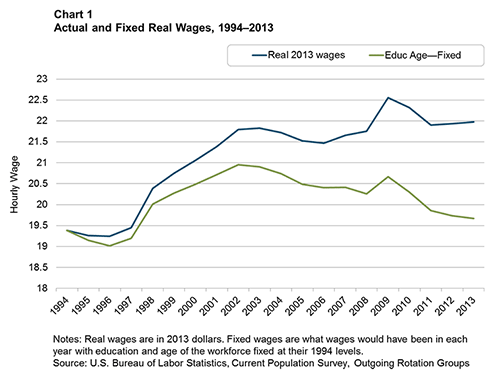This chart, a version of which Pavlina Tcherneva posted on Twitter, has been getting a lot of attention (e. g., NYTimes, Vox, NPR, WaPo, Slate, Moyers & Co.).

The chart shows, for each postwar economic recovery in the United States (trough to peak), the share of income growth going to the bottom 90 percent and top 10 percent of the income distribution. And the trend is unmistakable. This is how Tcherneva puts it in a new One-Pager: “For the vast majority of people in the United States, economic growth has become little more than a statistical sideshow.”
This is a picture of an economy that has been broken for some time; well before the cartoonish result in the last partial expansion (during that 2009-12 period, the top 10 percent received 116 percent of the income growth [possible because the bottom 90 percent saw their incomes drop] — and the top 1 percent alone captured 95 percent of the gains).
But Tcherneva also has a particular view of how we can change our policies to help solve this problem. She writes about two ways of improving the income distribution through public policy:
“One is to work within existing structures and reallocate income through various income redistribution schemes after income has been earned. The other is to change the very way income is earned from the outset.”
The way we normally use fiscal and monetary policy to stabilize the economy represents a lost opportunity to affect the income distribution through the second channel, she says. Most conventional policies operate by aiming primarily to boost investment and growth, with the employment effects following as mere byproducts of this process. These conventional stabilization tools (including fiscal pump-priming) don’t do enough to disrupt what she describes as a broken “income-generating mechanism”; one that benefits capital over labor and the incomes of high-wage workers over low-wage workers.
Tcherneva argues that direct job creation policies are different. They can stabilize the economy by targeting the incomes and employment prospects of people at the bottom of the income scale, rather than, for instance, waiting for the effects of improved bank balance sheets to trickle down through the income distribution. By having the government fund employment in the public, nonprofit, and social entrepreneurial sectors for all who are ready and willing to work, her “bottom-up” reorientation of fiscal policy is meant to bring about full employment while raising incomes at the bottom of the distribution faster than those at the top.
As Tcherneva points out, severe income inequality doesn’t just raise concerns about distributive justice, it’s also a serious economic problem: for instance, the Levy Institute’s last strategic analysis argued that inequality has been a significant driver of financial instability in the US economy.
Download the One-Pager: “Growth for Whom?” (pdf)
Related: An older version of this chart appeared in a Levy working paper, and more recently, in an article published in the Journal of Post Keynesian Economics.







 ShareThis
ShareThis